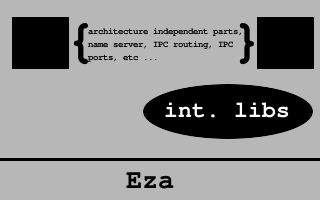[Index] [Back] [Next]
Ikernel:
Ikernel mainly separated by two parts is are Eza and Arch independent
part.
Eza is a architecture depended part, how you can understood, it's
provide an abstraction layer for the other parts. It's like a
nanokernel i.e. we're have something like nanokernel for each other
hardware platform (in example x86, powerpc, amd64, arm, etc ...).
Eza has unitified interface for upper level part and each architecture
"nanokernel" following this instructions and standarts. It makes a
portability simple and easy for other parts. Originally Eza is writing
for the intel x86 32 bit architecture, because this arch more
populated and easy to take it up with documentation.
Eza working with memory, cpu, address spacing and translation,
prebooting process, and contain a basic boot loader with low level
memory manager.
Arch independent part contains a set of the some filesystems that
working directly with Eza, a set of the libs, JP protocol stack, IPC
mechanismes, caching subsystems, extended virtual filesystem, elf
binary support, basic memory manager, visual notificating system, name
server for the servers, IPC routing, servers loader and a basic
initialization system and access control server.
For simple understanding look for the following illustration:
 It's illustrate all the subsystems of the Ikernel, that mainly
separated to make a development process more transparency and
easy.
It's illustrate all the subsystems of the Ikernel, that mainly
separated to make a development process more transparency and
easy.
Each of the part not so hard and have standart unitified interface to
the other subsystems, that makes it's modification and working on it
faster, preventing the bug fixing.
In example for the data structures in the ikernel there is a libruary
with unitified interface that supports all the needable data
structures and it presenting a good abstraction layer for it.
[Index] [Back] [Next]

